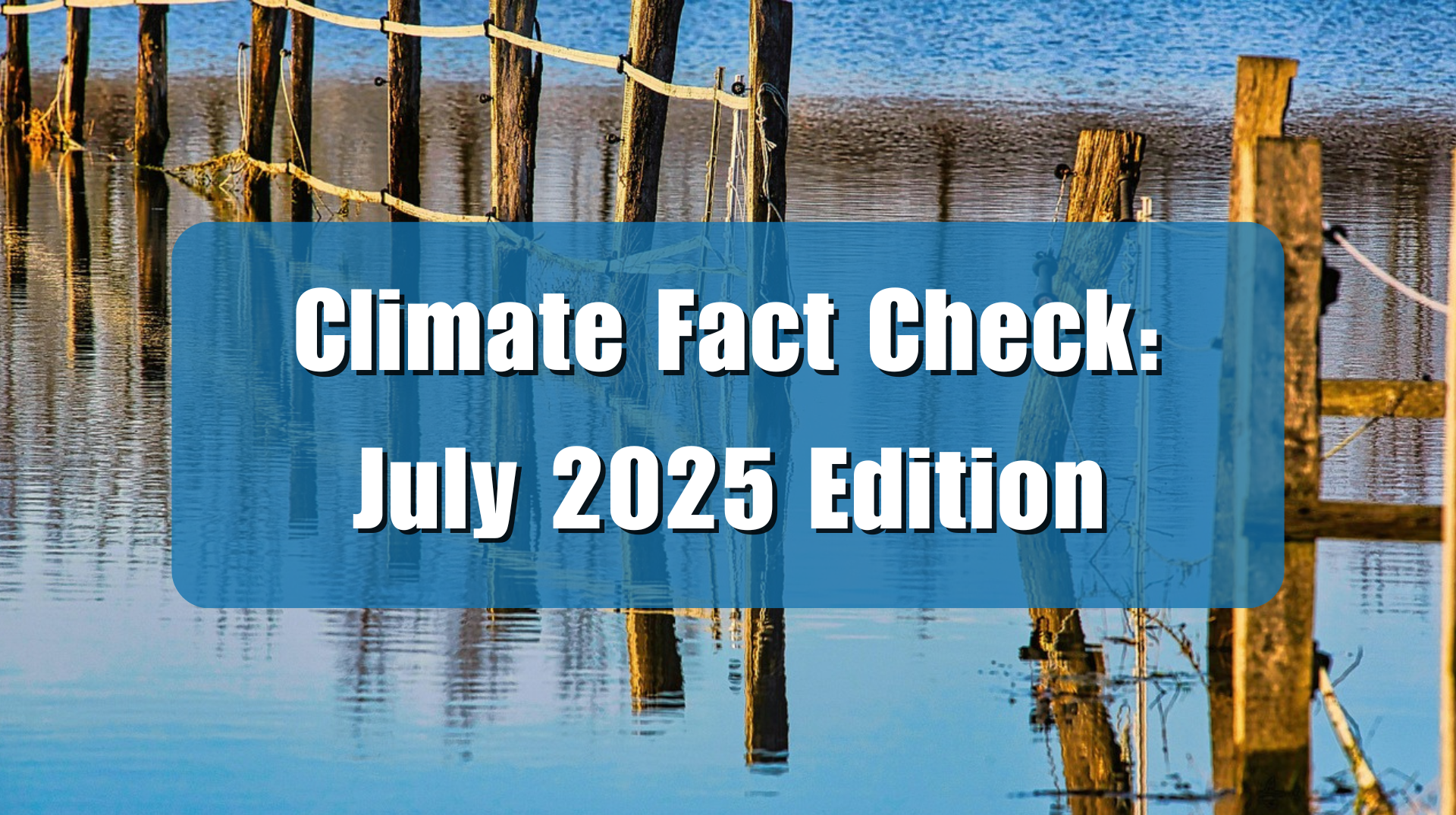Foreword by Anthony Watts:
I was sent this by email, apparently “Scientific American” doesn’t believe in fairness after publishing what is clearly a smear. Peer reviewed science welcomes rebuttal, smear review, not so much. Dr. Steve Koonin writes:
I attach a response that I submitted yesterday to Scientific American. Not surprisingly, they declined to publish it.
Please do distribute my response freely among your contacts or websites.
Steve Koonin
Dr. Koonin’s response:
Scientific American has published a criticism of me and my recent book, Unsettled. Most of that article’s 1,000 words are scurrilous ad hominem and guilt-by-association aspersions from the twelve co-authors. Only three scientific criticisms are buried within their spluttering; here is my response to each them.
The first criticism concerns rising temperatures:
A recent Washington Post column by conservative contributor Marc Thiessen repeats several points Koonin makes. The first is citing the 2017 National Climate Assessment to downplay rising temperatures—but the report’s very first key finding on the topic says temperatures have risen, rapidly since 1979, and are the warmest in 1,500 years.
In fact, Unsettled explicitly acknowledges a warming globe, but also the problems in comparing instrumental and proxy temperatures that weaken confidence in the “warmest in 1,500 years”. The book’s Chapter 5 criticizes in detail the 2017 report’s misleading and inaccurate representation of a different temperature metric, US extreme temperatures. To the surprise of many, the country’s warmest temperatures have not increased since 1960 and are no higher in recent years than they were in 1900.
The authors go on to offer:
The second is Thiessen quoting Koonin’s use of an outdated 2014 assessment on hurricanes to downplay climate concerns. But the newer 2017 report finds that human activity has “contributed to the observed upward trend in North Atlantic hurricane activity since the 1970s.”
In fact, Unsettled’s Chapter 6 discusses the description of hurricanes in the 2014 report, in the 2017 report, and in more recent research papers through 2020, including an authoritative 2019 assessment by eleven hurricane experts. None of those studies claim any detectable human influences on hurricanes.
Finally, we’re given:
A third point downplays sea level rise by portraying it as steady over time, cherry-picking reports from the Intergovernmental Panel on Climate Change. In fact, the rate of sea-level rise has quadrupled since the industrial revolution, as climate scientists pointed out years ago when Koonin made this same argument.
In no sense does Unsettled portray sea level rise as “steady over time”. Rather, the book’s Chapter 8 does quite the opposite, describing the full decadal variability as portrayed in the IPCC reports and subsequent research literature, but somehow omitted in the 2017 National Climate Assessment. The IPCC statement that rates of rise between 1920 and 1950 were likely similar to those of recent decades complicates attribution of recent trends.
It is telling that these three criticisms cite Thiessen’s column rather than what
I’ve written in Unsettled. That they are readily countered suggests the authors haven’t read the book or, if they have, they aren’t acting in good faith. That’s precisely the same unprofessional behavior found in the easily rebutted “fact check” of, again, a review of Unsettled, not the book itself.
To paraphrase a statement attributed to Einstein, “If I were wrong, it wouldn’t take a dozen scientists to disprove me – one would be sufficient.” As I write in Unsettled, I welcome serious, informed discussion of any of the points I raise in the book. Unfortunately, the article by Oreskes et al. falls well short of that standard.
Steven E. Koonin is the author of the bestselling book Unsettled: What climate science tells us, what it doesn’t, and why it matters.
You can listen to a podcast conducted by H. Sterling Burnett, managing editor of Environment & Climate News and a research fellow for environment and energy policy at The Heartland Institute.
In his new book “Unsettled,” Physicist Steven E. Koonin, Undersecretary for Science in the US Department of Energy under President Barack Obama, explains how climate research is being undermined and mispresented. Our current state of knowledge about the climate and human influences indicates there is no climate crisis. Hurricanes, tornados, heat waves, and droughts are not getting worse and deaths related to extreme weather events are declining. The public doesn’t know this because prominent research bodies, some individual scientists, the press, environmental lobbyists, and politicians are ignoring uncertainties and mispresenting what climate research shows in order to persuade the public that we face a climate crisis. Misrepresenting climate science undermines science itself and democracy.





















What is the correct temperature and how is that arrived? No one can answer that question. Second, show me a predictive thermodynamic model of the globe which describes the temperature versus altitude with the troposphere pause and ionosphere heating and pause. Then show me by increasing the trace gas in the atmosphere, CO2, by a step change of 100 ppm that the temperature profile gets altered after that model has been validated against the Maunder Minimum. All these so-called scientists and their assertions are garbage unless you have such a predictive model. If you wave a $100M grant funding in front of this pseudo-scientists they will produce whatever you wanted.
Scientific American ceased to be a reliable source of scientific information over a decade ago. Like so much of the MSM, it has abandoned impartiality and instead become an advocate for popular causes.
NASA states that it has been calculated that the temperature of the atmosphere had increased 1/2 of a degree over the past 20 years (their website). Ok, but the question that comes to mind is, how was that temperature calculated? The temperature of the air varies greatly over the entire surface of the planet and is affected by many factors. There are two ways to get a temperature: measure it or calculate it. It is not possible to measure a single temperature for the entire planet unless the entire planet constantly has the same temperature. The temperatures on the surface vary widely for a large number of reasons. First, the temp varies by time from day to night (and even year to year). Even the same spot is constantly changing temps as time passes. It warms up during the day, reaches a peak and cools down at night. Also temp varies by altitude. The temp at the surface of the ground can be very hot, but if one were to raise up straight up in the air, the temp would get cooler and cooler and at 40,000 feet it could be freezing. Also, the temp varies from the northern hemisphere to the southern hemisphere. While we are sweating here, those further south are freezing in the winter, with everything in between. Forests tend to be cooler, swamps are muggy and hot, and rainforests are too in a different way, deserts are hot and dry (mostly) etc. Even the temp of the ocean can vary in different locations at different times for different reasons. Temp is affected by weather, jet streams, storms, ocean currents, cloud cover, etc. – all can change the temp dramatically, if only for a time. Plus, I am sure, there are yet other factors that can change the temp on the earth. Let’s not forget the seasons and how we all go from sweating to freezing in just a few months and back again. Changes in sunlight intensity have an effect. The point is, the earth is a maelstrom of changing temps for all kinds of reasons, so how can scientists say that they measured the temp of the atmosphere with such accuracy that they say that it has gone up 1/2 of a degree? That has to be a calculated temp. Info on temps are gathered from all over the world and are averaged through some kind of computer program to produce a number. The problem here is that the calculated result is only as good as the computer program and there are certain assumptions that have to be made. Even just averaging all the numbers, considering that they are constantly changing, would not produce a exact result. I have never heard any scientist explaining the process by which they perform these calculations. It would be very interesting to hear some details on this. However, considering the complexity and variations, can they really calculate that the temp of the earth has gone up by only 1/2 of a degree over 20 years? The atmosphere changes from year to year. Can they say there is no margin for error in their assumptions and calculations? What if they are wrong?
And now SA is offering more weak commentary. https://www.scientificamerican.com/article/vapor-storms-are-threatening-people-and-property/
Koonin makes the truth obvious. Why Scientific American has gone from a reputable science mag to a scientist smearing mag is a mystery. I can only conclude that their mag was originally too science intense that the readers gave up on buying it. Or their editors and staff are the new LUDDITES focused on making a profit ahead of scientific truth…..
Judith Curry got it right about here article years ago on the “ERROR CASCADE”! What a relief it is to finally find KNOW the truth after years of belief mixed in with so much confusion.
musings of a log truck driver
The day is quickly coming when a humble, concerned for mankind, inventor, will build a sympathetic harmonic resonance amplifier tying into earth’s natural frequencies – in his garage -and connect it to his house’s electrics and disconnect from the grid. He will give his invention to everyone for the benefit of all people all over the planet doing his best to keep it out of the hands of big money and greedy corporations. The change will shatter the established order. The modes of energies we have reflect the harmony or disharmony of the overall state of humanity. Today’s world is like an internal combustion engine. Loud, terribly inefficient banging and crashing up and down spitting out pollution. It reflects only the present stage of our evolvement and we will grow into a greater embrace of ourselves and this realm. There is no climate crisis, and never has been. To recognize changes in climate as a natural aspect of our lives is right but to think we are the creators of doom is as irresponsible as those whose hearts are closed to the interconnectedness of everything and foolishly trash what they see. As we shift in appreciation of this world and each other we reevaluate the tenants of equality of opportunity for everyone and their benefiting from their ingenuity and innovation. The robbery of peoples ingenuity through taxes stops. The manipulation of peoples thoughts and emotional wellbeing through propaganda fake news dies as people see through the bullshit. We experience what we expect. We are each other’s successes. As we enlarge our perspective new forms of motive power will effortlessly and automatically manifest that reflect quiet, smooth and affordable applications of energy. But loving each other comes first. Tomorrow’s new forms of power will be a direct reflection of our interconnectedness and concern for each other. We, considered “the fortunate” have the responsibility to make the world the best possible place for all those needing clean water, affordable energy, jobs and prosperity. Only the small minded and self motivated stand in the way. And they are demonstrating who they are every day. A world blossoming and growing for the well being of everyone not just lining the pockets of a few at the expense of everyone else. The winds of change are strengthening. The real climate change is the collapse of the old guard and awakening of new possibility embracing the well being of every person on this wonderful planet.